Cut-Resistant Gloves
Extensive Collection of Cut-Resistant Gloves for Ultimate Hand Protection
Liberty Safety has an extensive cut-resistant glove range that provides hand protection in various work environments. Our cut-resistant work gloves are designed to protect workers from common workplace hazards, including cuts, lacerations, abrasions, and other hazards that can hinder job performance. Choose from a vast selection of FroGrip® cut-resistant gloves. Individual glove styles and materials are chosen to suit the ideal needs of your work environment. Rating systems for gloves (including ANSI update) ANSI/ISEA 105 addresses the classification and testing…
Liberty Safety has an extensive cut-resistant glove range that provides hand protection in various work environments. Our cut-resistant work gloves are designed to protect workers from common workplace hazards, including cuts, lacerations, abrasions, and other hazards that can hinder job performance.
Choose from a vast selection of FroGrip® cut-resistant gloves. Individual glove styles and materials are chosen to suit the ideal needs of your work environment.
Rating systems for gloves (including ANSI update)
ANSI/ISEA 105 addresses the classification and testing of hand protection for specific performance properties related to mechanical protection (cut resistance, puncture resistance, and abrasion resistance), chemical protection (permeation resistance, degradation), and other performance characteristics such as ignition resistance and vibration reductions based on standardized test methods.
Understanding the ANSI/ISEA 105 is essential when choosing the correct level of hand protection needed for workplace safety.
There are two key areas: cut-resistance ratings and new needle puncture resistance.
1. Cut-Resistance Ratings: A singular test method is used and classified using nine levels expressed as (A1 – A9). The levels indicate how many grams of cutting load a glove can withstand from a sharp blade before being penetrated.
2. New Needle Puncture Resistance: This solution provides valuable information for medical, recycling, sanitation, and law enforcement sectors. In the testing process, a 25mm hypodermic needle replaces the probe typically used for puncture resistance testing.
Finding the proper cut-resistant gloves for your work
When choosing the right glove for better hand protection, many things should be considered, including puncture or heat resistance protections, additional comfort options, and a firmer grip. The requirements depend on the work and the worker, and both should be evaluated carefully before choosing the best protection.
Depending on if your workers encounter nuisance/low cut hazards, moderate, high, or extreme risks will determine what material or combination of materials would be ideal for your work environment and everyday hazards.
We offer cut-resistant gloves in various materials and styles, such as engineered yarn knit shell, Kevlar®, and canvas, to name a few.
If you have questions, need assistance choosing the right glove, or would like more information about our products, contact one of our knowledgeable representatives.
Showing 1–20 of 36 results
-
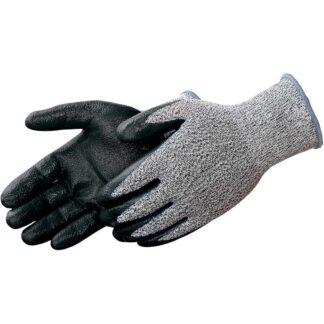 F4930BK
F4930BKX-Grip®
Black Foam Nitrile Cut Resistant Gloves
-
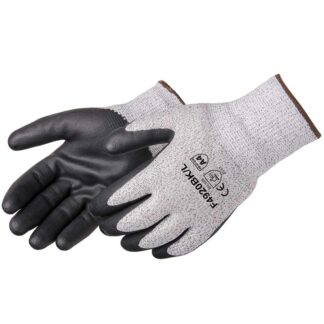 F4920BK
F4920BKZ-GRIP®
Black Foam Nitrile Cut Resistant Gloves
-
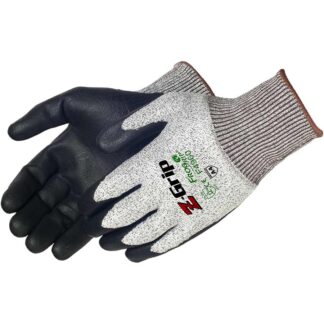 F4960
F4960Z-Grip®
Black High Density Polyurethane Cut Resistant Gloves
-
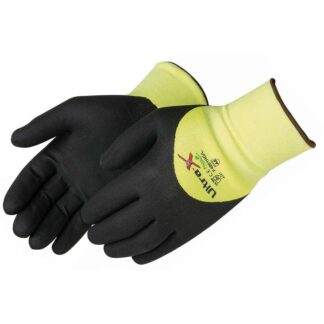 F4901HG
F4901HGUltra-X™
Black Microfoam Nitrile Cut Resistant Gloves
-
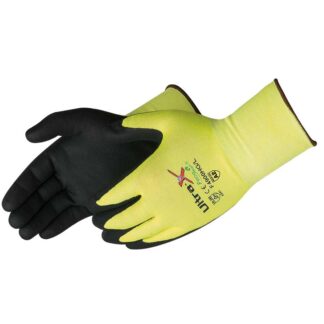 F4900HG
F4900HGUltra-X™
Black Microfoam Nitrile Cut Resistant Gloves
-
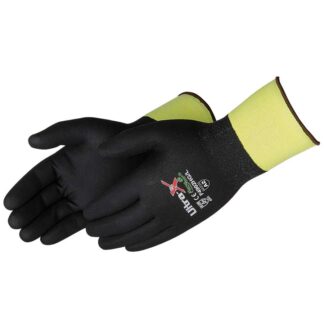 F4902HG
F4902HGUltra-X™
Black Microfoam Nitrile Cut Resistant Gloves
-
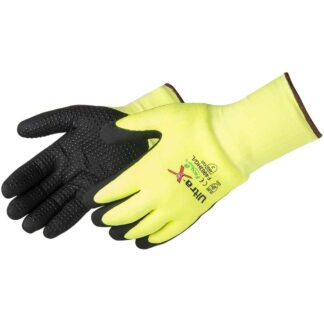 F4903HG
F4903HGUltra-X™
Black Microfoam Nitrile Cut Resistant Gloves
-
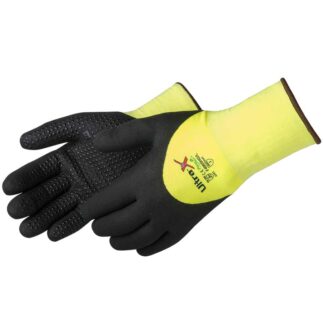 F4905HG
F4905HGUltra-X™
Black Microfoam Nitrile Cut Resistant Gloves
-
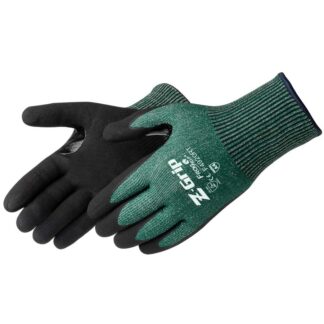 F4920RT
F4920RTZ-Grip®
Black Microfoam Nitrile Cut Resistant Gloves
-
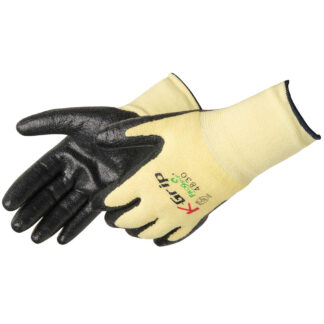 4830
4830K-Grip®
Black Nitrile Cut Resistant Gloves
-
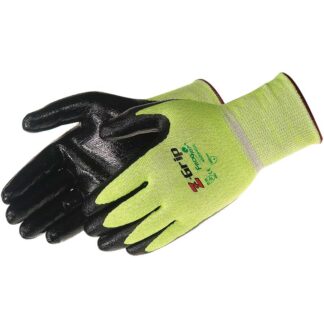 4920HG
4920HGZ-Grip®
Black Nitrile Cut Resistant Gloves
-
 F4923
F4923Arctic-Z™
Black PVC Cut Resistant Gloves
-
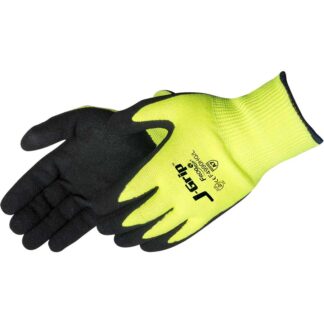 F4990HG
F4990HGJ-Grip®
Black Sandy Foam Nitrile Cut Resistant Gloves
-
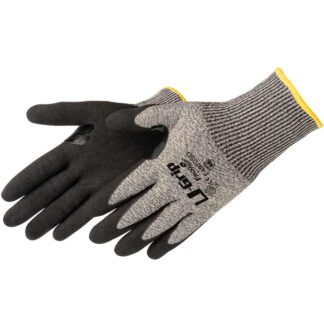 F4970SD
F4970SDU-Grip®
Black Sandy Foam Nitrile Cut Resistant Gloves
-
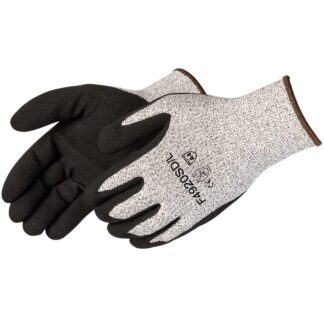 F4920SD
F4920SDZ-GRIP®
Black Sandy Foam Nitrile Cut Resistant Gloves
-
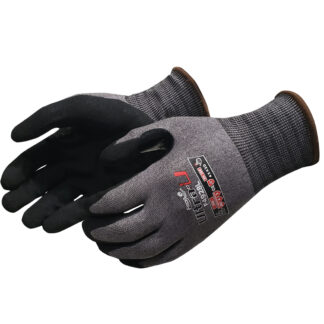 F4928
F4928Ultra-U™
Black Sandy Nitrile Cut Resistant Gloves
-
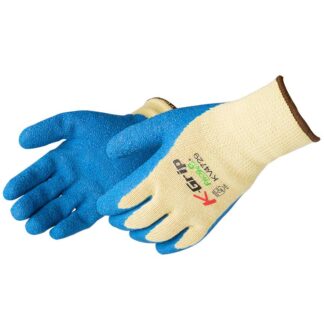 KV4729
KV4729K-Grip®
Blue Latex Cut Resistant Gloves
-
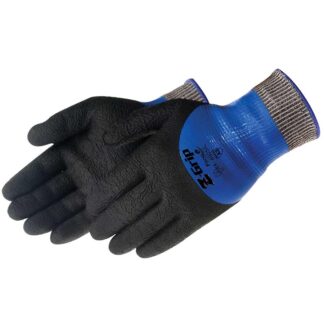 4925
4925Z-Grip®
Blue Nitrile Cut Resistant Gloves
-
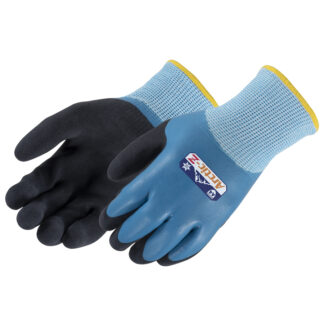 F4922
F4922Arctic-Z™
Fully Blue Latex Coated Cut Resistant Gloves
-
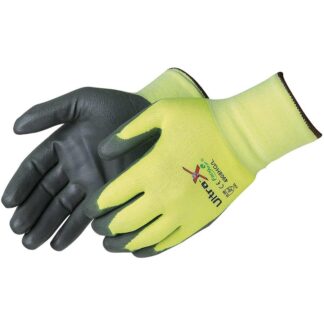 4908HG
4908HGUltra-X™
Gray Polyurethane Cut Resistant Gloves
FAQ
The gauge of a glove indicates the number of knitting needles or stitches per square inch. As the number of stitches increases, so does the gauge, resulting in a thinner glove. Gloves with higher gauges offer better dexterity and comfort. An added benefit of a higher-gauge glove is that it provides a high level of tactility, and therefore, it will be easier to do specific jobs that require fine-tuning skills.
Conversely, when there are fewer stitches per inch of yarn, the yarn is thicker, and thus the glove is thicker. For example, a 7-gauge glove is less dexterous and flexible than an 18-gauge glove. If the task at hand requires fine-tuning skills, this is an issue. However, if the job requires heavy lifting that includes sharp and abrasive objects, selecting a lower-gauge glove may be advantageous.
Understanding the gauge is crucial in selecting gloves tailored to the specific demands of the job at hand.
Cut-resistant gloves vary in their resistance and strength. The higher the cut level, the more heavy-duty and cut-resistant the glove is. The ANSI/ISEA 105-2016 standard, set by the American National Standard Institute, features a nine-level scale, offering a quick guide to identifying the suitable cut-resistant gloves needed based on the task at hand.
At Liberty Safety, all our cut-resistant gloves undergo third-party testing and certification. This ensures that our cut-resistant gloves consistently meet the standards set for cut resistance.
Refer to the chart below for a visual representation of all nine cut levels, ranging from A2 to A9.
| ANSI/ISEA 105-2016 Cut Resistant Ratings |
| A1 – 200 gm, Light Cut Hazards |
| A2 – 500 gm, Light-Medium Cut Hazards |
| A3 – 1000 gm, Light-Medium Cut Hazards |
| A4 – 1500 gm, Medium Cut Hazards |
| A5 – 2200 gm, Medium-High Cut Hazards |
| A6 – 3000 gm, High Cut Hazards |
| A7 – 4000 gm, High Cut Hazards |
| A8 – 5000 gm, High Cut Hazards |
| A9 – 6000 gm, High Cut Hazards |
The replacement frequency of cut-resistant gloves depends on several factors, including the intensity and duration of use, specific tasks involved, and the materials the gloves are made of. As a general guideline, conduct the following regular inspections to ensure the integrity of your gloves.
- Visible Wear and Tear: Check gloves routinely for noticeable signs of wear and tear, such as holes, cuts, or abrasions. If any damage is detected, it’s advisable to replace the gloves promptly.
- Coating Integrity: A more subtle sign that it may be time to replace your gloves is that the coating has worn off. This can often be identified if the material of your glove feels thinner than when you first got it or if the material begins to feel more abrasive to the touch.
- Stains and Contamination: While dirt and stains are common, your gloves should not retain excessive amounts of contaminants after washing. If gloves remain heavily soiled with dirt, chemicals, oil, or other substances, it’s a clear signal to invest in a new pair of cut-resistant work gloves.
Being attentive to these indicators ensures that your cut-resistant gloves deliver optimal protection and maintain their protective integrity while on the job.
Palm coatings do not directly increase cut resistance; however, they provide improved grip, reducing the likelihood of slips with sharp objects and, thus, potentially fewer opportunities for cuts. Palm coatings can also help extend the life of the shell.
Yes, cut-resistant gloves can usually be washed. However, it’s important to follow the manufacturer’s guidelines for industrial laundering instructions. It is recommended to hand wash them using mild detergent and lukewarm water, and then air dry. Avoid using bleach or harsh chemicals that may compromise the integrity of the gloves.
Showing 1–20 of 36 results
